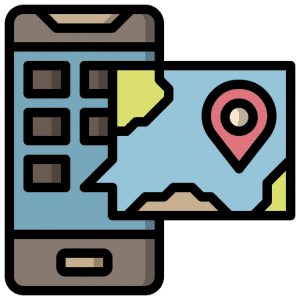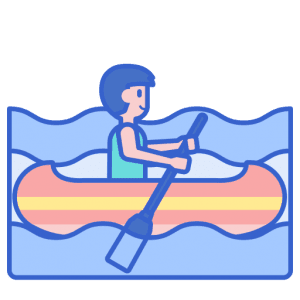
Paringa (265 km from Adelaide)

Paddle Time Allow 2 – 3 days

Easy – Moderate
Approx. 33.5 km . Allow 2 – 3 days to complete the trail
Always check weather and wind conditions before setting out.
Visit BOM for weather conditions
Easy – Moderate - River and slow-flowing broad backwater
Do the five weather safety checks
Shady trees, café, toilets. Grassy area, picnic tables and BBQ
Free parking with shady trees
 Paddle SA is the governing body of paddle sport and recreation in South Australia. It leads and supports paddling in South Australia and encourages the safe exploration of our waterways.
Paddling Trail South Australia has a range of Paddling Trails to suit different abilities.
Know your ability.
Paddle SA is the governing body of paddle sport and recreation in South Australia. It leads and supports paddling in South Australia and encourages the safe exploration of our waterways.
Paddling Trail South Australia has a range of Paddling Trails to suit different abilities.
Know your ability.  Canoe the Riverland hire and deliver kayaks in this area.
835 Murtho Rd, Murtho, SA 5340
Link to waterproof Chowilla map available for purchase online
Canoe the Riverland hire and deliver kayaks in this area.
835 Murtho Rd, Murtho, SA 5340
Link to waterproof Chowilla map available for purchase online  If you have a smartphone or tablet you can download the free Avenza PDF Map app and have interactive paddling trail maps on hand when you need them. The app uses your device’s built-in GPS to plot your real-time location within the park onto a map. The app can be used without a network connection and without roaming charges. You can also measure area and distance, plot photos, and drop Placemark pins.
If you have a smartphone or tablet you can download the free Avenza PDF Map app and have interactive paddling trail maps on hand when you need them. The app uses your device’s built-in GPS to plot your real-time location within the park onto a map. The app can be used without a network connection and without roaming charges. You can also measure area and distance, plot photos, and drop Placemark pins.
Canoe Launch near Border Cliffs Customs House (GPS: 33.9727 S; 140.9575 E)
Start at Canoe launch near Border Cliffs Customs House (GPS: 33.9727 S; 140.9575 E).
Paddle downstream to Suders Creek, known as the “Shute” (approximately 150m). This is a fast-flowing, narrow creek (entered by leaving the main river on the right-hand side). The Shute connects the Murray River and Hypurna Creek. Once you enter The Shute, you will be swept right through it. Consider reconnoitring it from land to check for current obstacles.
NOTE: If the “Shute” is considered too hazardous for the skills of the group the alternative is to paddle upstream for approximately 1.5 kms to a portage point just before the 638 Km marker (Point W: GPS: 33.9828 S; 140.9686 E). Portage into Hypurna Creek (approximately 75 m) and then paddle back down to the junction of the “Shute”. This alternative route has an approximate distance of 2.2 kms in addition to the 75m portage.
When you reach Hypurna Creek from the “shute” turn left and continue to the junction with Salt Creek (approximately 200m) at Point H (GPS:33.9711 S; 140.9683 E). The stumps of an old footbridge may be visible in the water near this junction.
Turn right into Salt Creek and continue to paddle along this waterway. You will notice that there are two branches of Punkah Creek that appear on the LHS at approximately 4 kms and then again 750m later at Point J (GPS 33.9636 S; 141. 0016 E). Do not take these, but remain on Salt Creek.
You have now crossed the border into NSW and will continue to crisscross the border a number of times throughout this trip. NOTE: In NSW you are in Kulkurna (formerly Tareena Station) and camping is not permitted.
After a further 4.3kms Salt Creek divides into 2 branches at Point L (GPS 33.9797 S 141.0032). At this point you are on the border between SA and NSW.
Note: the LH branch is approximately 1.8km long and is the deeper waterway but may have some snags to negotiate. The RH branch is approximately 4.2kms in length and travels along a shallower horseshoe lake which in low river flow years may be dry. However large flocks of up to 150 birds of black swans or Australian pelicans may be seen in the horseshoe lake when there is water about.
The LH and RH branches meet at Point M (GPS: 33.9803 S 141.0164 E). Turn left here (or continue straight along if you have taken the RH branch) to follow Salt Creek. Paddle for a further 7.8km.
Look for a creek entrance to your right at Point S (GPS: 34.0188 S; 141.0469 E) noting that this is still Salt Creek here; turn right and continue for approximately 3.2km to the junction with Hypurna Creek on the RHS Point Q (GPS:34.0215 S; 141.0250 E). Note this section could have fallen trees to negotiate.
Turn right into Hypurna Creek and continue to paddle for approximately 5.6km to the next significant junction at Point N (GPS: 33.9943 S; 140.9950 E).
Note: you are now back in South Australia!
Take the right hand branch and continue for about 4 km where there will be a sharp bend to the right at this point. Soon after this bend there is a rusted tin marker identifying the portage point (Point W: GPS: 33.9828 S; 140.9686 E) which will return you back to the Murray River.
Turn right in the river and you will soon be back to your initial launch point at the Border Cliffs Canoe Launch site.
Shady trees, café, toilets. Grassy area, picnic tables, and BBQ belong to Customs House so ask before using them.
Located at the northern end of the Border Cliffs campground. Enjoy a one-and-a-half hour return walk from the car park and discover this special wetland system. Take the 350m detour to the lagoon and observe a variety of native birds including great egrets, superb fairy-wrens and white-faced herons. Return to the main path and take-in excellent views of the Murray River sandstone cliffs in the distance.
Along the way, watch for parrots, bats, possums, kookaburras, kangaroos, lizards, and other wildlife. See National Parks SA website for information.
The Customs House (under the Border Cliffs at Port Murtho) was originally established to take some control over the large volume of river craft travelling between various ports on the River Murray. New South Wales, which claimed the river as part of its colony, built customs houses at its state borders to impose duties on items being transported by river from Victoria and then from South Australia. This caused much dissent and anger with other colonies and they too eventually established customs houses at state borders.
In January 1884 the SA Governor dispatched a party to establish a customs post on the SA/Vic border. On 8th April 1884, a reserve for a customs house to be known as Port Murtho was gazetted. The Customs House was built by December 1884 at a cost of less than $1000 in current terms. The Customs House watched over river trade for about 20 years and was served by four customs officers in that time.
Legend has it that river-boat skippers objected to paying their way and often goods were smuggled over the state borders or dumped to avoid paying taxes. One skipper who objected to paying the then impost of 10 pounds as poll tax on his Chinese cook had the fellow walk through the scrub past customs, supposedly to rejoin the boat further upstream, however the cook never made it back to the riverboat – he was later seen working on a sheep station further North. At the time duty on a sheep was (in today’s money) 10 cents, pigs 50 cents, cows $2 and horses $4 – little wonder the skippers objected to paying! From time to time Customs Officers fired shots over the bows of passing steamers, whose skippers had ‘forgotten’ to call in and declare their loads.
In 1901, Federation brought an end to customs houses, free trade was allowed between states. The advent of railways to river towns (especially in Victoria and NSW) saw the riverboat trade decline. In 1902, the Commonwealth Gazette announced The Customs House at Port Murtho in the State of South Australia was to close.
Paddling Trail South Australia has a range of Paddling Trails to suit different abilities.
Know your ability
These are easy to access kayak and canoe trails through the Adelaide, Fleurieu Peninsula, Riverland, Murray River, and the Coorong.